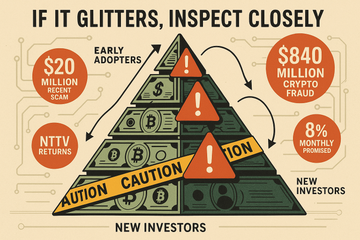You’ve probably heard the term “Ponzi scheme” tossed around in the news or maybe even whispered at a dinner table when someone’s investment went bust. But what’s really going on under the hood of these frauds? Why do people, even savvy ones, keep falling for the same old trap? Let's pull back the curtain on Ponzi schemes—past, present, and, believe it or not, future.
So, What Exactly Is a Ponzi Scheme?
At its core, a Ponzi scheme is simple, almost embarrassingly so: investors are promised high returns with little or no risk. But instead of profits from actual investments, payouts are quietly made using money from newer investors. With no legitimate business activities, it's only a matter of time before the whole thing unravels. Sound familiar? If it’s too good to be true, you know how the saying goes.
How does it play out?
- Slick sales pitch: The schemer lures in the first round of investors, usually family, friends, or newcomers blinded by numbers that outshine the bland offerings at banks or the stock market.
- Word spreads fast: Happy early investors brag about their gains, fueling a rush of new believers. Before long, everyone wants in.
- The magic act: New contributions pay off the old hands, giving the illusion of real success. On paper, everything looks rosy—or at least until someone asks for too much money back at once.
When withdrawals outweigh new funds, the act falls apart. And let’s be honest—it often ends in tears, lawsuits, and dashed dreams.
Rewinding the Tape: The Roots of the Racket
Fun fact: the name “Ponzi scheme” comes from Charles Ponzi, an Italian immigrant who pulled off one of the most audacious financial deceptions back in 1920 America. Promising to double people’s money in months, Ponzi coaxed modern-day millions from an unsuspecting public. He bought little more than time, covering owed returns with fresh cash and living the high life—until it all crashed in spectacular fashion.
But Ponzi wasn’t the only one. Adele Spitzeder was at it in 19th century Germany, swindling folks with phony mining investments. And in 1880s Boston, Sarah Howe offered ‘safe’ deposits just for women, promising 8% monthly returns, then skipping out when the truth emerged. Their stories prove it: greed, hope, and a good story travel well across borders and eras.
Ponzi in the Age of Bitcoin?
Now, let's talk about the elephant in the room—cryptocurrency. These days, social media and blockchain buzzwords have put Ponzi schemes in a whole new light. Take the recent Nigerian case: after an $840 million crypto-themed scam, regulators are warning about new schemes piggybacking on the crypto craze. There’s always a shiny angle—be it “AI trading bots” or “guaranteed yield farms”—but the bones of the scam remain unchanged. (Seriously, how many times do folks have to get burned?)
Did you know that reputable hardware wallet companies like Trezor and Ledger often publish warnings about such scams? Their advice: always confirm the legitimacy of investment offers, especially those promising cold-storage access, and never share your seed phrase. Let’s be clear: hardware wallets like Ledger cannot protect you from sending money to a scam, but their secure design means you, and only you, control your crypto—unless you hand over the keys.
Recent Headlines: The Charade Continues
Think Ponzi schemes are ancient history? Just last year, a Utah man dubbed the “Mormon Madoff” was convicted after his $20 million scam targeting fellow churchgoers blew up. His story exploded across TikTok, and his wife, left holding the bag, went public about the emotional and financial wreckage (source).
Meanwhile, class-action lawsuits are being launched against companies accused of facilitating Ponzi-like “drive planning” schemes (source). Even banking giants like Bank of America find themselves entangled in bankruptcy fallout, as trustees try to claw back investors’ lost fortunes (source).
On the international stage, regulators are on high alert, especially wherever crypto and quick riches collide. Nigerian authorities, for instance, are doubling down with strong warnings to curb a new wave of digital fraudsters (source).
Spotting the Red Flags (Before It’s Too Late)
So, can you actually spot a Ponzi scheme? Sometimes, the clues are right there, waving like a neon sign:
- Unrealistic or guaranteed returns. Come on, markets just don’t work that way.
- Vague business model or secret investing strategies. If you can’t explain it to your grandma, maybe steer clear.
- Pressure to reinvest or “keep it in the system.” Hint: you should always feel free to cash out—unless it’s a scam, of course.
- Lack of transparency or regulatory oversight. Where are the audits? Who’s watching the henhouse?
And, almost always, you’ll notice the ringleader is charismatic, persuasive, and pretty slick with words. Remind you of anyone?
Protecting Yourself in a World Full of Promises
Let’s be real here: no software or hardware can guarantee you total safety in the world of investing, especially crypto. But simple habits go a long way. Do your research—double, even triple check licensing, company registration, and actual business activities. Check forums, independent reviews, and beware of too many glowing testimonials. If you use a crypto hardware wallet like Trezor or Ledger, remember: these tools keep your assets secure, but won’t rescue you from scammers masquerading as legit offers. If something smells fishy, step back.
And spread the word. A lot of people, including the sharpest minds, get caught by the emotional pull of “just one lucky break.” Remind your friends. You never know who might be feeling tempted.
The Takeaway: If It Glitters, Inspect Closely
Honestly, the Ponzi story is as old as time—just dressed in new tech and fancier language. Whether in old Boston, bustling Lagos, or in your favorite Telegram group, the core lesson remains: trust is precious, and so’s your hard-earned money. Don’t let greed or hope blind you. The next time someone promises you riches with zero risk, ask yourself: who’s really getting rich here?











